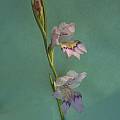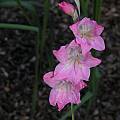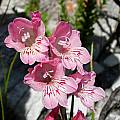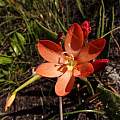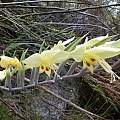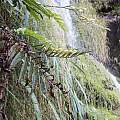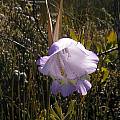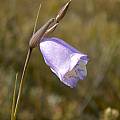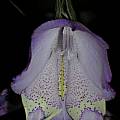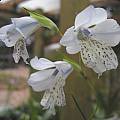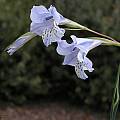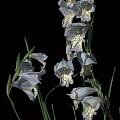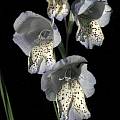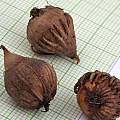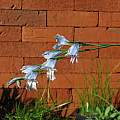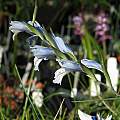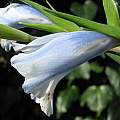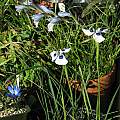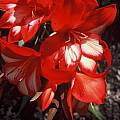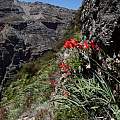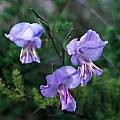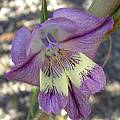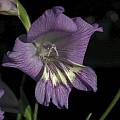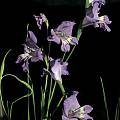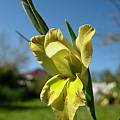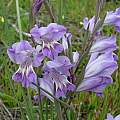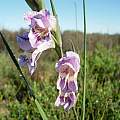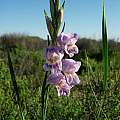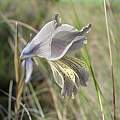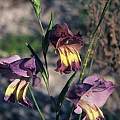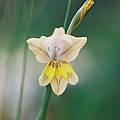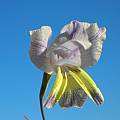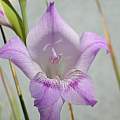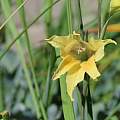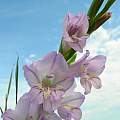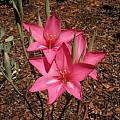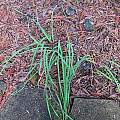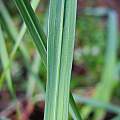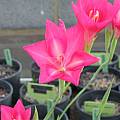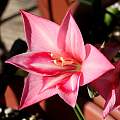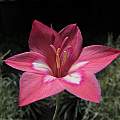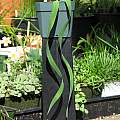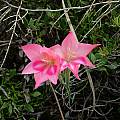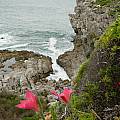Winter rain Gladiolus like their winters wet and mild and may need a dry summer dormancy. They are often less hardy, reaching down to USDA zone 8 at most.
Page 1: G. abbreviatus... Page 3: G. carneus... Page 4: G. deserticola... Page 5: G. grandiflorus... Page 6: G. inflexus... Page 7: G. marlothii... Page 8: G. mutabilis... Page 9: G. pulcherrimus... Page 10: G. saccatus... Page 11: G. teretifolius...
Gladiolus brevifolius Jacq. blooms in fall before producing leaves and has small pink, gray or brownish flowers with yellow markings on the lower tepals. Plants grow 20-50 cm tall. It is found on sandstone and shale slopes in the north and south western Cape, South Africa. The first two photos of garden grown plants by Mary Sue Ittner and Bob Rutemoeller. The third photo was taken by Rod Saunders. The last picture was taken near Napier in the Overberg by Cameron McMaster.
Gladiolus brevitubus G.J.Lewis grows on rocky sandstone slopes in the Southwestern Cape and flowers in spring. Plants grow from 12 to 35 cm high. Flowers are unusual, resembling a Tritonia, orange with yellow markings at the base of the lower tepals. Leaves are linear with lightly thickened margins and midribs. The photo was taken December 2013 by Rachel Saunders on steep slopes in the mountains near Hermanus.
Gladiolus buckerveldii (L.Bolus) Goldblatt is a species restricted to a few sites along permanent rivers in the northern Cederberg of the western Cape. Plants grow out of nearly vertical moss covered cliffs. Growing from 80 to 125 cm, it has a horizontal spike of 12 to 20 ivory to greenish cream flowers, each with a spade or heart shaped dark red mark in the center of the lower tepals. It flowers in summer. In the past it was included in Antholyza as Antholyza buckerveldii because of its elongate floral tube (wide and cylindric above and slender below) and then was moved to Petamenes. In 1971 it was included in Gladiolus. Photos taken January 2014 by Rachel Saunders. It was growing on a cliff next to a waterfall.
Gladiolus bullatus Thunb. ex G.J.Lewis is found on sandstone slopes in fynbos in the southwest Cape and the Agulhas plain. This species is reported to be difficult in cultivation. It has bell-like blue flowers with yellow markings and is hooded. Height: 50-80 cm. The first photo by Bob Rutemoeller was taken at Boskloof, the second and third by Cameron McMaster in the Overberg, and the last a close-up from Alan Horstmann.
Gladiolus caeruleus Goldblatt & J.C.Manning (syn. Gladiolus gracilis var. latifolia G.J.Lewis) is found on limestone outcrops and calcareous sands close to the coast in the Southwest Cape. The flowers are pale blue with dark speckles on the lower tepals. Plant height: 40-60 cm tall. It blooms in winter. Flower photos by Bob Rutemoeller, Mary Sue Ittner and Bob Werra. Corms from Telos Rare Bulbs by M. Gastil-Buhl on a 1 mm grid.
The photos below were taken by Nhu Nguyen of plants bought from Telos Rare Bulbs. The last photo shows a blue triad of this species with Moraea aristata and Tecophilaea cyanocrocus.
Gladiolus cardinalis Curtis grows on wet cliffs and waterfalls in the southwestern Cape area of South Africa where the corms are wedged into cracks in the rocks where they are protected. Corms and roots must be constantly wet. This species flowers in the driest time of the year in midsummer (mid December to mid January), and is pollinated by the mountain pride butterfly. It is often found growing together with Disa uniflora, an orchid pollinated by the same butterfly. Growing from 55 to 90 cm tall, it has bright red flowers with white spear-shaped marks. This very beautiful species was one of the parents of modern day hybrids. The first photo was taken by Rod Saunders. The second photo from Rachel Saunders was taken January 2013 where it grows in a waterfall that plunges down the side of the mountain off a cliff that is probably 500 m high.
Gladiolus carinatus Aiton is found on sandstone slopes or deep coastal sands in many areas of the Cape. It flowers late winter to spring and can be blue to violet or yellow, rarely pink, often with yellow markings on the lower tepals. Height range: 30-60 cm high. The first two photos were taken by Mary Sue Ittner; the first photo was taken September 2001 in the Southwest Cape and the second shows the flower of a plant grown from seed and flowering March 2004. The next two were taken by Bob Werra. The last photo from Cameron McMaster shows a yellow form grown from seed by Rhoda McMaster.
The first five photos were taken in the Western Cape in Hopefield, Elands Bay, and near Napier by Cameron McMaster. The last photo is from Rod Saunders.
The photos from Alan Horstmann show different forms.
Gladiolus carmineus C.H.Wright is a narrow endemic of the southwestern Cape coast (winter rainfall) where it grows on rocky sandstone cliffs within the sight of the sea. Flowers appear in the fall (mid February to April) and are pale to deep pink. Each of the lower three tepals and sometimes the upper lateral tepals have a median whitish streak surrounded by a pale mauve halo. There are three to five reduced leaves on the flowering stem. Foliage leaves produced by plants that did not flower appear later and are long and trailing, 8 to 10 mm wide, glaucous with a lightly thickened midrib. Height range: 30-50 cm. They grow during the wet winter and spring, drying off in late spring.
Some PBS members report that they get better results from this bulb in pots if watering is started in late summer (August in California). Others report that it blooms reliably in dry ground even if given no supplemental water. You may need to experiment to see what works best in your climate. It is definitely easier to grow in coastal climates. It has naturalized in the coastal Northern California garden of Bob Rutemoeller and Mary Sue Ittner. They scatter seeds about after the pods split open. The first four photos were taken in this garden. The third shows the long narrow foliage leaves of a clump in February 2014. The fourth is a closer view of a leaf. Mary Sue was asked why these leaves look different from the ones in Nhu's photo below. She did a tour of her garden and found leaves of different widths, some curled, some upright, and some flat. So it may depend on how and where the plants are growing, as well as how old they are. Photo 5 was taken in September, 2005 by David Victor, which flowers in the UK during September, followed later by the foliage. Flower stems and foliage are grey-green. David's plants hold typically four or five flowers on a spike. The last photo is from the summer hemisphere and was taken by Bill Dijk.
Photo 1 is of a slightly lighter-colored form grown by Michael Mace. Photos 2-3 were taken by Nhu Nguyen. Photo 3 shows the pendent habit of the leaves, which makes sense since it grows on cliffs.
Photos taken in habitat near Hermanus, South Africa by Cameron McMaster.
Page 1: G. abbreviatus... Page 3: G. carneus... Page 4: G. deserticola... Page 5: G. grandiflorus... Page 6: G. inflexus... Page 7: G. marlothii... Page 8: G. mutabilis... Page 9: G. pulcherrimus... Page 10: G. saccatus... Page 11: G. teretifolius...
